Back when I lived in Washington state, I would occasionally get a Canadian quarter in my change—because this was long enough ago that people still regularly purchased things with cash. The Canadian quarters were easy to spot, because every U.S. quarter looked the same—George Washington on the front, an eagle on the back—except for the Bicentennial drummer who’d show up once in a blue moon. Then came the state quarter series, and that seemed like a recipe for chaos: suddenly the design on the back of a quarter could be just about anything, right? Yet in practice it wasn’t really an issue. As wild as some of the designs got—the Montana quarter certainly didn’t blend in, as cattle skulls are rarely featured on coinage—I could still generally tell at a glance what was an American quarter and what wasn’t. It wasn’t until a quarter of a century after the inauguration of this new era that I finally got a quarter in my change that I genuinely believed must be fake. See, following the fifty state series came a decade-plus of national parks, and now the mint is doing a series on American women. Most of these look pretty normal, at least by modern standards:
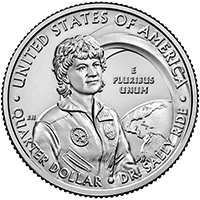
Even the more daring designs are generally recognizable as American currency:
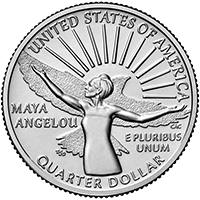
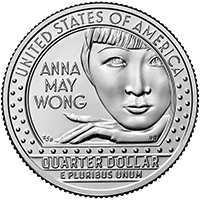
But I got this one:

And, I mean—c’mon, you can’t just use a blank background! This looks like a slug! I’ve seen arcade tokens that look more like real coins! Scrawling the text of the coin onto the figure’s dress may seem clever, but that text is illegible. In the absence of a standardized design, the fine print on these coins does a lot of heavy lifting—not just in identifying who this even is (based on what little I could read, I thought it might be someone named Blanca Cruz—I had to go online to discover that it’s someone named Jovita Idar), but in identifying this piece of metal as real money.
All right, on to the big news of the month. So, Ellie wanted me to make her some poutine, but my attempt to find acceptable cheese curds in the East Bay had been a bust. I saw someone online saying that Rainbow Grocery in San Francisco town had them, so on the first of the month I went over the bridge, got off the freeway, took a few turns onto 13th Street, came to a stop at the back of a line of cars that were waiting for the light to change… and was rear-ended by a Volvo SUV driven by the wife of the founder of a local evangelist megachurch. She hit my car with enough force to turn it into the middle vehicle in a three-car pileup. No one was hurt, fortunately, but my car was banged up:
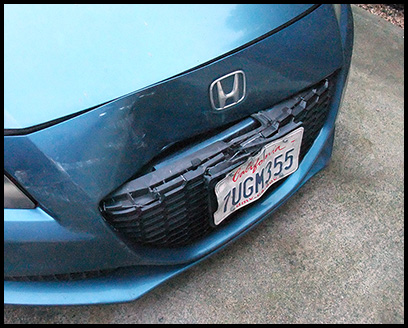
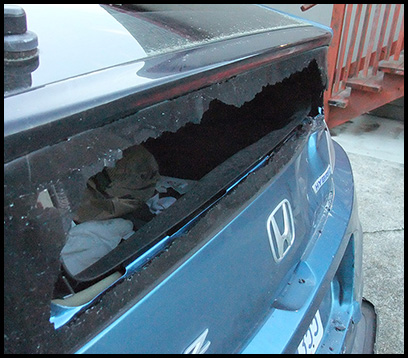
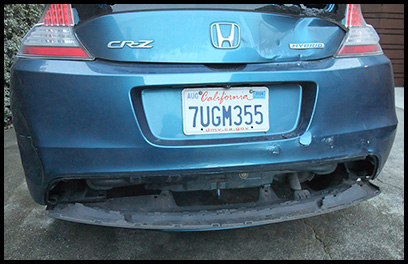
Apparently I didn’t know how any of this works. After trading information with the other two drivers, I thought that the next step was to wait for the police to come and make a report. That’s what had happened the previous times I had been in car accidents, in 2002, 1992, and 1978. (I wasn’t at the wheel during the ’78 crash.) But I didn’t have a cell phone to call in the police, and the other two drivers just drove off without making any such call. My car was driveable enough that I was able to limp to a parking spot, from which I happened to see a police car a couple of blocks ahead. I walked up to it and knocked on the window; the officer inside said that as long as there were no injuries, it was an insurance matter rather than a police matter. So when I got home, I called up my insurance company and reported the crash. My policy has a $1000 deductible, and that plus the inevitable rate hikes were making this look like a very expensive bowl of poutine indeed. It was only at the end of an hour-long call that the insurance agent said, “So, since our determination is that you were zero percent at fault… are you sure you want to make a claim with us instead of with the at-fault driver’s insurer?” And I was like, waaaaait—you’re telling me that if I’m not at fault, the other insurance company pays for everything? No deductible? No rate hikes? I even get a free rental while my car is in the shop? Half a week from turning fifty and somehow this was brand new information to me.
- The at-fault driver’s insurer came up with an estimate of the car’s value; the body shop came up with an estimate of the cost of repairs. The repair estimate was $500 higher. The car was therefore declared totaled. No repairs: I would just get a check for the value of the car. That value was knocked down by its pre-existing dents and dings, but the penalty was offset by a bonus for its low mileage: I bought it in 2017 assuming I would be driving it all over Northern California as part of my tutoring job, as had been the case dating back to 1994, but my stint as a public school teacher, followed by my tutoring career moving online during and after the pandemic, meant that the only significant mileage put on the car post-2018 came on drives to and from Portland. So, unexpectedly, I found myself shopping for another car. I had hoped not to find myself in such a situation for a while, because I don’t really like many cars these days. My top priority in a car is that it be small: the parking spaces that open up along the local curbs are invariably tiny, such that only with a sub-sub-compact am I able to fit into them. Plus I want good mileage: my beloved first-generation Insight, which I drove from 2006 to 2017, got seventy miles to the gallon. The car I’d been driving since then was the Insight’s successor, the Honda CR‑Z, which gets half as many miles per gallon but which has a button you can push to give the engine enough power to get up hills. The CR‑Z was discontinued in 2016, so I looked forward to seeing what Honda would roll out in its place, to fill the niche in its lineup that, prior to the Insight, had been filled by the likes of the S2000, the Del Sol, and the CRX. And the answer was: nothing. Honda no longer makes a two-seater. It’s hard to find a two-seater from any automaker these days. Hell, it’s hard just to find a car. In the U.S., at least, it’s all trucks and vans and SUVs now. I looked at the Hyundai Veloster, which has similar styling to the CR‑Z even if it does have four seats, but it has a bunch of unresolved recalls (the official advice actually says that, while waiting for Hyundai to devise a repair, it would be best to park the car away from any structures you don’t want to set on fire). I looked at the Mazda Miata, but I briefly had one of those in the ’90s and discovered that I don’t like convertibles. And I looked at the Toyota GR86, a four-seat coupe like the Veloster but one that’s currently being produced and gets good reviews… but even the used ones run for about double what my insurance payout was projected to be, and I didn’t want to be on the hook for years of car payments just because I happened to find myself in front of an SUV in which Jesus had taken the wheel. So I wound up focusing on getting a new CR‑Z.
- As you’ve seen, my old CR‑Z was blue.
I hadn’t set out to buy a blue one.
When I was in need of a new car—the Insight was
really on its last few miles, with every single light on the dashboard
blinking in distress—I went searching for a CR‑Z
and found an amazing deal in
Pittsburg.
Every car value calculator I consulted said that it was listed for
about half its true value.
And, according to the listing, it was purple!
One of the many ways the world has grown worse over the course of the
21st century is that color has disappeared from our roads: the stats
I’ve read vary slightly, but as a ballpark figure, we can say
that about 35% of motor vehicles are gray / silver, 30%
are white, and 20% are black, leaving only 15% with an actual
hue—and almost all of those are red or blue.
So I was pretty jazzed about the prospect of getting a purple
car.
I got to the dealership a few minutes before it opened, found the
car in the parking lot, and… the car was blue.
I was still going to buy it: like I said, it was a great deal, and
blue was acceptable.
And when I did eventually see a purple CR‑Z, I felt even
better about winding up with a blue one: the purple shade was less of
a Concord grape and more of an eggplant.
That is, it was very close to black, and to the extent that it did
glitter in direct sunlight, the brown notes came to the fore more than
the violet ones.
So, I put the purple car out of my mind, spent seven years in the blue
one, and then bang.
What I found when I went looking for a replacement was that comparable
CR‑Zs were slightly more than my insurance check was projected
to be: essentially, I’d be paying two or three thousand dollars
in order to get my car replaced by one with fewer dents and maybe
five or ten thousand fewer miles on the odometer.
Alternatively, I could go the other way and break even, but wind up
with a car a couple years older and/or with forty or fifty thousand
extra miles under its serpentine belt.
And then I tried a more obscure car listing site than the ones I’d been consulting, and a new listing popped up. Yes, it was for a car that was a couple years older, and the mileage was eye-popping: it was closing in on two hundred thousand miles traveled. But it looked like it was in good shape, the Carfax report was clean… and it cost a third of what a lot of other CR‑Zs were going for. And it was purple! Suddenly my previous objections to the color felt like sour grapes, or sour eggplants: I could finally get the purple one! And have enough money left over to finally upgrade my Obama-era computer! Even the location wasn’t too terrible: the car was located in California, just at the wrong end of the state. I would have to find a way to get to Murrieta, about five hundred miles away. The question was, did I want to shell out hundreds and hundreds of dollars to fly down to So Cal and get a rental car to take me to Murrieta for a test drive, only to discover that the deal was too good to be true? That was when I discovered: yes, it was way cheaper to fly to Portland out of Oakland… but it’s way cheaper to fly to LAX out of SFO. Hell, with a little advance planning, you can get there for $37. I was aiming to leave in three days, so my ticket was a bit more expensive… but it was about a quarter of what I was looking at to fly from Oakland to the airports a bit closer to Murrieta, ONT and SNA. So I decided to give it a go. Long story short:
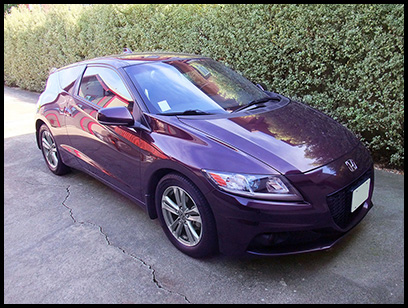
Long story slightly longer: no red flags with the test drive, and no red flags during the sales process. I’d seen that there was another purple CR‑Z in Fullerton that was going for over twice the price, and that dealership had abysmal ratings; when I looked into why, it turned out that most of the complaints had to do with take-home prices that were far beyond the advertised price, due to add-ons like mandatory Lojack and what have you. In Murrieta it was just the usual taxes and DMV fees. I put the whole thing on my credit card. Then came the real test: driving the car five hundred miles home. And the car did a lot better than I did on that count. No automotive problems whatsoever. But after all those hours behind the wheel I felt like I’d been in a wreck. (That may sound like hyperbole, but it’s actually understatement: I felt much worse than when I’d literally been in a wreck!)
The reason that was the real test, and the reason I didn’t mind getting a car with two hundred thousand miles on it, is that it will serve very light duty here. I work from home now. Having a car is more of a convenience than a necessity for me. But it’s a hell of a convenience. If going to the Berkeley Bowl meant walking half a mile to the bus stop, sitting on a bus for twenty minutes, and then walking another half mile, probably in the pouring rain due to all the atmospheric rivers that sweep through here nowadays—and then doing it all over again in the opposite direction while schlepping around a couple of grocery bags… dang, that ain’t no way to live. So I’m guessing that this car might be adding on a grand total of fifty miles a week from here on out. But they’re fifty miles that radically improve my quality of life.
All corporations are bastards, but a select handful do make an effort to generate customer goodwill, and for me, at least, it pays off. Back in the day, when I would rent cars, I would pretty much always go with the cheapest option, at least from among those companies whose reviews weren’t shockingly poor. And that meant having to wait out a bunch of upsell (are you sure you don’t want a bigger car? are you sure you don’t want the insurance? are you sure you’re making the best decisions here?) and having to risk a bunch of fees. I was generally able to avoid them, but hanging around those counters waiting for my turn, I overheard a lot of angry back-and-forth between employees and aggrieved customers. But now I tend to rent from Enterprise, because their whole gimmick is that (sometimes) you pay a little bit more up front, but in exchange, they actually try to give you a good experience. Four examples:
Ellie got us a reservation at a Michelin-starred restaurant in San Francisco town for my birthday… and then my car got wrecked, and the restaurant was far from public transport. Ellie thought we should get a rental car. I ordered an economy car from Enterprise. When the representatives found out that I was getting it to go to my birthday dinner, they upgraded me to a sports car, no extra charge.
The at-fault driver’s insurer paid for a rental car for me while my car was in the shop. This turned out not to be very long, since once the car was declared totaled I had to return the rental, but still, it was handy to have for a few days. I forgot to put gas in the car before returning it. The company the insurer had partnered with was Enterprise. When the representative said that the gas tank was reading a gallon lower than when I had checked it out, she said I could either pay $6.49 or go gas up the car and bring it back. I said I’d go gas it up. She said, “Actually, don’t worry about it,” and waived the fee. (This does make me wonder whether they also would have waived the fee had I elected to just pay it. Or was this like when other rental companies ask whether you’re interested in upgrading to a larger size for just ten dollars more, and you say no, and they give you the larger car anyway because it’s actually the only car they have left?)
One of the big reasons I went through with taking a test drive five hundred miles from home was that I saw that there was an Enterprise location across the street from the dealership. I hoped that I could therefore get a rental at LAX, drive it to Murrieta, buy the CR‑Z, and drop off the rental right then and there. When I went to the Enterprise web site, I discovered that minivans were 25% cheaper than other vehicles, including economy cars. So I reserved a minivan. When I got to the LAX Enterprise location, I asked, “Hey, I reserved a van, but I don’t actually need one—is there any chance I might be able to get a smaller car for the same price?” The representative said, sure, I could take any car I wanted apart from the sports cars. So I effectively got a 25% discount on the small car I wanted just by asking for one.
Finally, when I walked into the Murrieta location, I asked, “Hey, I rented a car at LAX—can I return it here?”, and the representative replied, “Absolutely!” I had figured that her next line would be, “You just need to pay a $75 relocation fee!” or something—when renting from other companies in the past, I’d paid similar fees when to return vehicles to different locations, and that was when I’d made arrangements in advance. Here I was just some rando springing an LAX car on the Murrieta folks without warning. Hence I assumed that there would be a fee, maybe a hefty one, and I was willing to pay it given the deal I’d gotten on the CR‑Z. But no—there was no fee. The plan worked out even better than how I’d drawn it up.
So the thing I don’t get is this: yes, this kind of approach may well cement some brand loyalty. It may well be worth it to forego $6.49 here and $75 there so that, down the line, you’ll get $200 when I go on vacation and choose to rent from you over your competitors. But also—isn’t it just more fun to spring pleasant surprises on happy customers than it is to get an extra forty dollars here and there by bickering with them? Quite apart from any use it might have in market positioning, wouldn’t knowing that the company has earned a good reputation, in any industry, serve as a morale boost? Why is this philosophy so rare, then? Is it that those who set the policy to try to squeeze out extra profits by nickel-and-diming customers are so far removed from the day-to-day operations that they never experience the down side? Or is it that personality disorders are so common nowadays that the decision makers get their morale boost from fucking people over?
It turns out that the purple car does have one significant problem: the radio. When I was at the dealership, one of the older guys there chimed in that, oh, yeah, that CR‑Z had a trim level they’d never seen before, or the previous owner had added a bunch of extras piecemeal: a new steering wheel, a central console, tinting on the windows, and a touchscreen radio. Well, I don’t like the steering wheel (and have ordered a cover for it in the hopes that it will be a tactile improvement), I don’t like the console (and have moved it out of the way), and I don’t like the tinting (it’s scratched, and the scratches are distracting). But above all, I hate the radio. I would hate it even if it worked properly. It doesn’t have a volume knob! Every time a song comes on that’s mixed too loud, I reach out to turn it down and end up grasping at air. Instead I have to press the “volume down” button on the steering wheel, and the sound gradually grows less deafening as the radio goes BEEP BEEP BEEP with every point of reduction. Many features can’t be activated from the steering wheel at all, and must be selected by stabbing at the unyielding screen instead of pressing responsive buttons. But… on top of all that, it doesn’t work properly.
I have a thumb drive with about 3500 songs on it, give or take. I usually listen to them on shuffle mode. This radio is supposed to have one: the manual says you tap the “play random song” icon and you’re all set. Except what that actually does is play one random song. What the radio seems to be doing is picking one song and putting it into the #1 spot in the queue, because what it always plays next is the #2 song on the entire drive. The first songs on the drive are in the root directory, which contains songs by artists who have never released an album I own. These songs are ordered by release date. Thus, the #2 song on the drive is “California Dreamin’” from 1965. And it comes on after every other song! The only way to avoid it is to wait until the current song is almost over, turn “random song” off, turn “random song” back on to put a new song into the queue, and then fast forward to that new song… which will then be followed by “California Dreamin’” unless you do this every single time. While driving. So that radio has gotta go, because using it is like being trapped in Chungking Express.
 |
|||||
 |
 |
 |
 |
||
|---|---|---|---|---|---|
Tumblr |
this site |
Calendar page |
|||